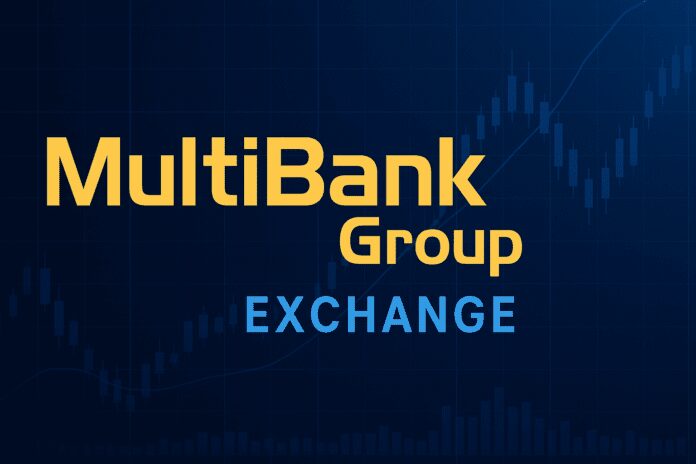The phrase MultiBank Group Exchange is going to start showing up in more investor conversations. A 20 year old traditional finance institution with more than 2 million clients and an average daily trading volume north of $35 billion is moving aggressively into crypto. They are not doing a small pilot; they are building an integrated, four pillar ecosystem that connects legacy brokerage flows, institutional infrastructure, retail crypto trading, and tokenized real world assets. This article breaks down who they are, what they are building, why it matters, and what the biggest risks and opportunities are for traders and investors.
Table of Contents
- Quick snapshot: Why MultiBank Group Exchange is suddenly relevant
- How they are attacking crypto: The four pillar blueprint
- How these pillars tie together: MBG, the native utility token
- Tokenomics, burns, and presale performance
- What makes MultiBank Group Exchange different from other exchange tokens and RWA platforms?
- How traders and investors might interact with MBG and the ecosystem
- Potential macro implications if MultiBank Group Exchange succeeds
- Where the biggest risks live
- Free crypto signal and practical trading tips
- What to watch next on the MultiBank Group Exchange roadmap
- Putting it all together: Should you care?
- Final take
- Frequently asked questions
Quick snapshot: Why MultiBank Group Exchange is suddenly relevant
If you have not heard of MultiBank Group, you are not alone. But this is exactly what makes the MultiBank Group Exchange story worth paying attention to. Founded in California in 2005, the company built a massive global brokerage business long before Bitcoin existed. Today it operates under 17 financial licenses across five continents and supports more than 2 million clients across 100 plus countries. Their average daily trading volume is reported at about $35 billion, a number that dwarfs the daily spot volume of most crypto exchanges.
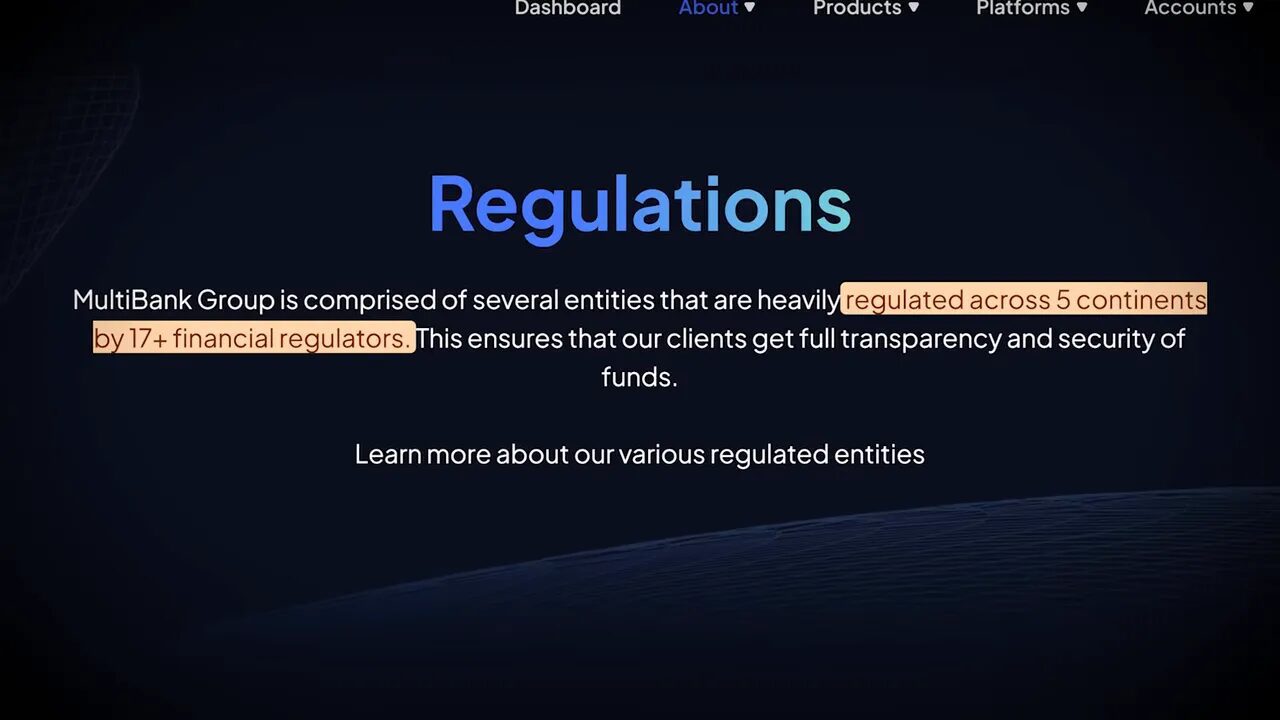
The MultiBank Group Exchange narrative is not just hype. In the first half of 2025 MultiBank reported $209 million in revenue and approximately $170 million of that as profit. That kind of cash flow is the engine that can fund ambitious crypto projects and a multi-pronged strategy that tries to bridge traditional finance and crypto.
How they are attacking crypto: The four pillar blueprint
MultiBank is not building just another token or single exchange. The MultiBank Group Exchange plan has four interlocking pillars. Each pillar is designed to feed the others and create a differentiated ecosystem:
- Pillar one: Legacy TradFi brokerage that funds everything
- Pillar two: MEX, an institutional-grade exchange for large players
- Pillar three: MultiBank IO, the regulated crypto exchange for retail
- Pillar four: A real-world asset marketplace focused on tokenized property
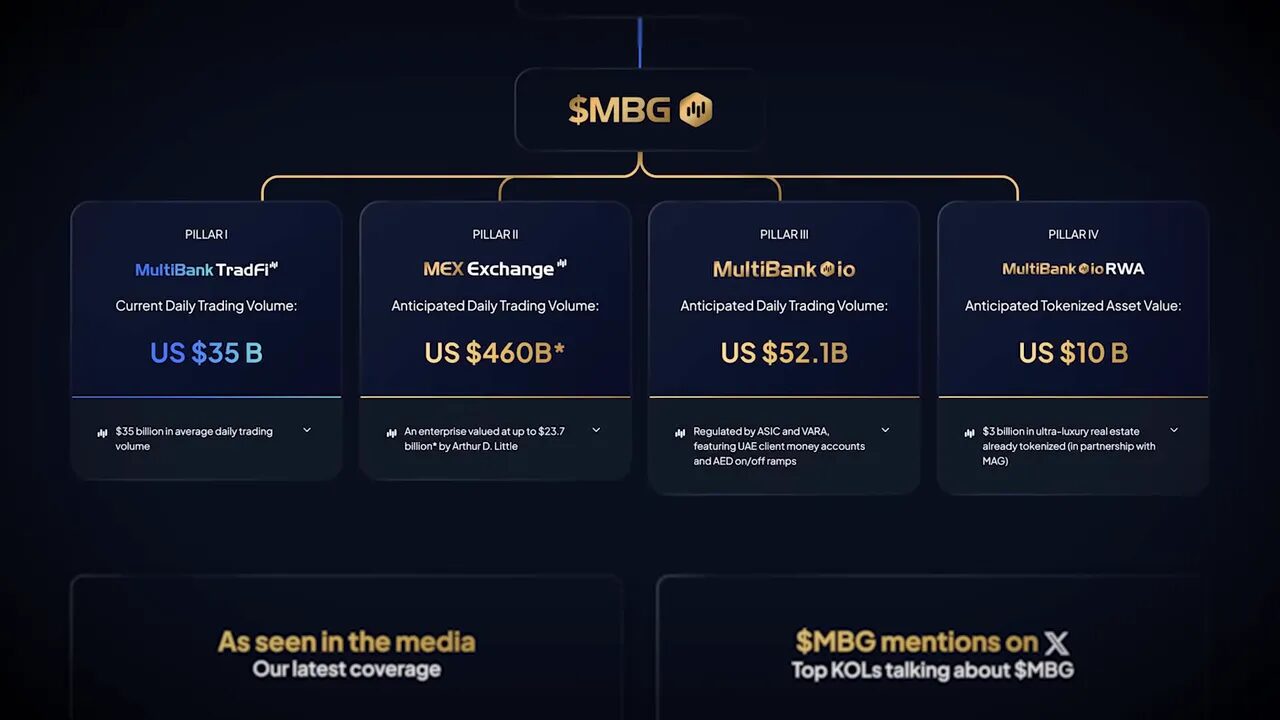
Pillar 1 — The TradFi engine
The first pillar is the existing brokerage business. This is the legacy financial infrastructure that has been generating consistent revenue for nearly two decades. Think forex, derivatives, stocks, and commodities. That business is the funding source and user base that makes MultiBank Group Exchange different from crypto-native players that started from zero.
Why does that matter? Because they already have regulatory relationships, license footprints, and capital. On top of that there are two million users who could be onboarded onto crypto products. For a company that can move $35 billion a day in flows, integrating crypto services becomes a logical extension rather than a moonshot.
Pillar 2 — MEX: institutional settlement and liquidity
Pillar two is MEX, an exchange built for institutional volume. The aim here is to create an environment where hedge funds, family offices, and asset managers can execute massive trades with low slippage, deep liquidity, and regulatory compliance. MultiBank’s press materials have claimed a valuation for MEX of $23.7 billion by consulting firm Arthur D. Little. That number is eye popping, but importantly, the valuation has not been independently published by Arthur D. Little in public record. Treat that claim with caution, but do not dismiss the strategic idea.
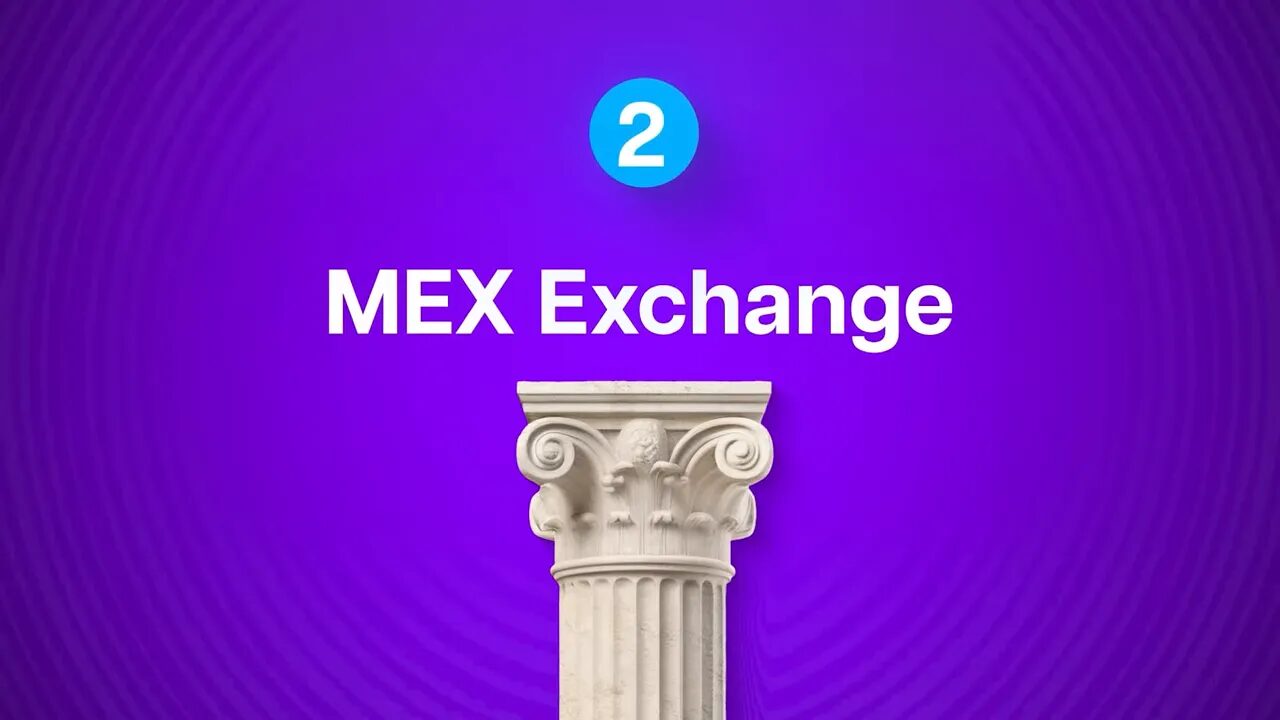
MEX is the infrastructure piece that ties the TradFi flows into crypto markets. The most interesting technical nuance is how MEX intends to use the native token for settlement, which I will unpack below. If MEX succeeds in attracting institutional counterparties it could create a self-reinforcing pipeline of liquidity, custody solutions, and revenue that differentiates the MultiBank Group Exchange ecosystem.
Pillar 3 — MultiBank IO: a regulated crypto exchange for retail
Pillar three is MultiBank IO, a fully regulated crypto exchange aimed at retail users. This is the consumer-facing leg of the MultiBank Group Exchange structure. MultiBank IO promises over 60 spot pairs, derivatives with leverage up to 125x, and institutional grade security through partnerships with firms like Fireblocks.
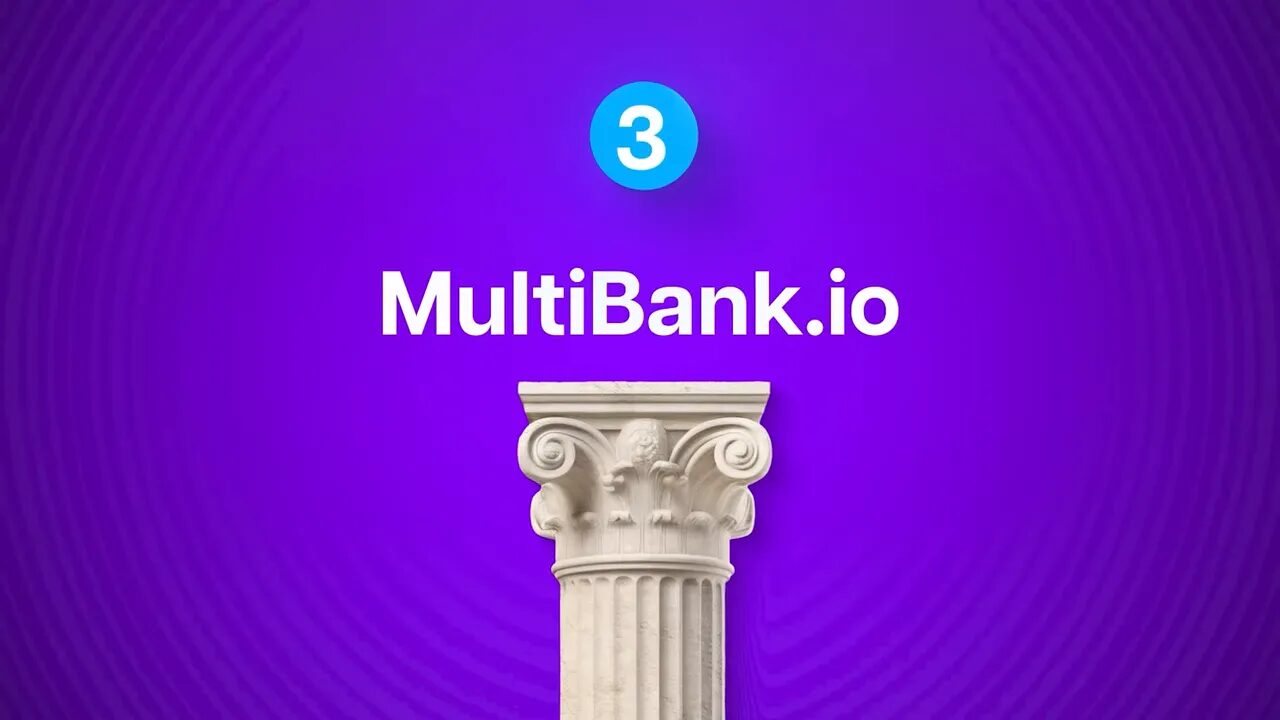
On the retail side, the advantages are twofold: experience and trust. MultiBank has spent two decades building trading platforms and regulatory footprints, and now they intend to apply that expertise to the crypto retail market. A lot of traders still prefer regulated venues when given the choice. If MultiBank IO can deliver a familiar trading experience with robust security, it will grab market share from less-regulated or lower-quality retail exchanges.
Pillar 4 — Real world assets: tokenized high-end property
This is the part of the MultiBank Group Exchange plan that has the potential to be truly transformational or painfully difficult to execute. MultiBank has announced a partnership with MAG, a large UAE real estate developer, as part of roughly a $3 billion deal to tokenize high-end Dubai properties such as Ritz-Carlton residences. The aim here is fractional ownership of luxury assets through tokenized securities. Instead of needing a six figure deposit to invest in property, a retail investor could own fractional exposure through tokens.
The short term goal MultiBank has stated is tokenizing more than $10 billion of real estate assets. To put this into context, the global real estate tokenization market sits around $250 billion in 2025 and Deloitte projects growth to roughly $4 trillion by 2035. Those numbers are huge, but tokenizing large volumes of assets comes with well-known problems: fragmented buyers, low secondary market liquidity, long lockups, and heavy regulatory friction.
The MultiBank Group Exchange playbook is to build a marketplace that addresses those problems directly. The platform claims it will provide more liquid secondary markets and infrastructure to allow fractional tokens to be traded more easily. The success of that claim depends on onboarding both supply (developers, asset owners) and demand (sophisticated buyers and retail), while navigating the regulatory frameworks across jurisdictions.
How these pillars tie together: MBG, the native utility token
All four pillars are designed to be glued together by a single native utility token called MBG. Think of MBG as functionally similar to exchange tokens like BNB, but with a few key differences tied to MultiBank Group Exchange ambitions.
Here is how MBG is positioned within the ecosystem:
- Standard exchange utilities: trading fee discounts and account tier boosts for MBG holders
- Staking rewards and priority access to token sales and launchpad events
- Institutional settlement: MBG is designed to be used on MEX for margin and settlement by large counterparties
- Direct integration into the RWA marketplace: MBG can be used to access tokenized assets and potentially earnings from those assets
The institutional settlement use case is the most interesting because it creates real economic demand for MBG beyond retail speculation. If hedge funds and asset managers use MBG as an on chain settlement token for large trades, that adds utility and locked demand. On the RWA side, revenues from tokenized property deals are meant to support a buyback and burn mechanism.
Tokenomics, burns, and presale performance
MultiBank announced a $440 million buyback and burn program and stated an ambition to burn up to 50 percent of total MBG supply over time. They executed an initial burn of nearly 5 million tokens in August, which shows they are moving on the program. The token presale sold roughly 7 million tokens in under an hour at about $0.35 per token, raising approximately $2.5 million from early investors.
For presale investors that is already a decent win. MBG traded up to roughly $1.15 in the early public market, which represents about a four times gain from presale. That performance is attractive, but remember MBG was still a small cap at under $100 million market capitalization at the time of public trading. Small caps can be hyper-volatile until much larger market cycles or sustained adoption reduce that volatility.
What makes MultiBank Group Exchange different from other exchange tokens and RWA platforms?
There are three main competitive edges worth noting.
- Credibility and regulation — MultiBank brings 20 years of regulated financial services experience and licenses across jurisdictions like Australia, Germany, and UAE. That is a major differentiator in an industry that still struggles with compliance and trust issues.
- Existing user and volume base — Two million TradFi clients and $35 billion in daily flows provide a huge potential distribution channel. If even a portion of those users adopt MBG or MultiBank IO, it changes the economics substantially.
- Integrated real-world asset strategy — Not every exchange token has a direct tie to tokenized high-value assets and a pledged buyback-and-burn funded by real asset revenues. That link could provide a revenue floor and clearer token utility if the RWA marketplace performs.
That said, the MultiBank Group Exchange initiative is not bulletproof. Tokenizing $3 to $10 billion of property is a monumental operational and regulatory challenge. Competing in the crypto exchange market puts them against entrenched players like Binance, OKX, and Gate who already have massive liquidity, brand recognition, and network effects. Execution matters. Strategy alone will not win the day.
How traders and investors might interact with MBG and the ecosystem
If you are a trader or retail investor, there are several possible touchpoints with the MultiBank Group Exchange ecosystem to consider.
- Trade MBG on MultiBank IO — Use trading fee discounts and staking benefits to reduce costs and earn rewards.
- Participate in the launchpad — Hold MBG to gain priority access to token sales and new listings.
- Access tokenized real estate — Use MBG to invest in fractional property tokens and potentially receive revenue distributions.
- Institutional settlement use case — For larger traders or funds, MBG could be used as a strategic settlement token on MEX, reducing friction in cross-asset trades.
For active traders, combining signals and execution is essential. If you want to spot short term opportunities on MultiBank IO or track when MBG breakouts occur, consider pairing technical and fundamental analysis with a reliable signal service. For example, a “free crypto signal” can help you identify high probability setups and manage trade entries and exits, especially in a market as volatile as small cap exchange tokens. Use signals as a tool, not a crutch — always confirm with your own view and risk management.
Potential macro implications if MultiBank Group Exchange succeeds
If MultiBank executes its plan, there are several big picture outcomes to watch for:
- Regulated on ramps scale — MultiBank could bring more traditional investors into crypto via familiar regulated products and custody options.
- RWA liquidity innovation — If their marketplace genuinely improves secondary liquidity for tokenized property, it becomes a case study for how to create tradable real world tokens at scale.
- Institutional settlement tokenization — MBG as a settlement token for large trades would validate the concept of exchange-native tokens as more than fee-discount mechanisms.
- Competitive pressure on incumbents — Big exchanges will notice a new player with deep TradFi roots targeting both their retail and institutional client bases.
That said, even if the MultiBank Group Exchange project doubles or triples MBG price, it will not automatically topple the market leaders. Market share gains happen incrementally and require sustained product quality, regulatory clout, and liquidity provisioning.
Where the biggest risks live
Every ambitious crypto project has risks. For MultiBank Group Exchange, the priority risk areas are:
- Execution risk — Building an integrated exchange, a custody-grade settlement layer, and a liquid RWA marketplace is operationally complex.
- Regulatory friction — Tokenizing real estate across multiple jurisdictions may trigger diverse regulatory responses and slow rollouts.
- Competition — Big incumbent exchanges and specialist tokenization platforms will compete for liquidity and issuer relationships.
- Token concentration and market cap — MBG began as a small cap token. Small caps are sensitive to market sentiment and can be volatile.
Practical investors should size positions appropriately, consider time horizons longer than short-term pump cycles, and monitor fundamental milestones like MEX adoption metrics, RWA tokenization volumes, and the continued execution of the buyback-and-burn program.
Free crypto signal and practical trading tips
For anyone planning to trade MBG or use MultiBank IO actively, combining on chain and off chain data with disciplined trade signals increases the odds of consistent outcomes. The volatility that small cap tokens exhibit means timing and risk control matter more than in blue chip tokens.
If you are exploring opportunities, a “free crypto signal” service can be useful to receive timely setups—especially around catalyst events like token burns, MEX onboarding announcements, or RWA issuance drops. Use signals to inform entries and set stop loss levels, but adapt them to your personal risk tolerance and portfolio goals. Remember that no signal is perfect; smart traders treat signals as an input into a broader strategy that includes position sizing, portfolio diversification, and exit planning.
What to watch next on the MultiBank Group Exchange roadmap
When evaluating progress, watch for these milestones:
- MEX onboarding of institutional counterparties and formalized settlement flows using MBG
- Volume and liquidity metrics on MultiBank IO, including derivatives usage and custody security certifications
- RWA token issuance numbers and the first secondary market trading volumes for tokenized property
- Continued execution of buyback and burn — size, timing, and transparency of burns
- Regulatory filings and company disclosures across jurisdictions that affect asset tokenization and custody
Each milestone should influence how you think about MBG’s fundamental value and the probability of the MultiBank Group Exchange thesis succeeding.
Putting it all together: Should you care?
The MultiBank Group Exchange story is not for everyone. If you are a long term believer in tokenization of real world assets, improved regulated on ramps, and the potential for exchange-native tokens to capture utility beyond fee discounts, then MultiBank’s playbook is compelling. They bring capital, regulatory experience, and a pipeline of users that crypto-native projects lack.
On the other hand, this is a complex, capital-intensive, and regulation-heavy plan. Tokenizing billions in real estate is not the same as listing meme coins. It requires legal structuring, custodian relationships, and buyer interest. Success is far from guaranteed.
For active traders, the short term opportunity is clear: MBG is a small cap that can move dramatically on news, burns, and listing catalysts. If you want an edge, combine fundamental tracking of MultiBank milestones with disciplined trade signals. Using a free crypto signal can help you catch momentum shifts and manage entries and exits without missing major moves. For longer term investors, track structural adoption of MEX and RWA velocity to determine whether the MultiBank Group Exchange thesis is playing out.
Final take
MultiBank Group Exchange is one of the more interesting examples of a traditional finance giant making a calculated move into crypto. They are not pivoting on a whim. They have decades of trading experience, multiple licenses, billions in flows, and a four pillar plan that attempts to stitch legacy finance to tokenized assets and modern exchanges.
That combination of credibility and ambition is powerful, but execution will be everything. If they can make institutional settlement, retail trading, and RWA marketplaces work together, MBG could become more than another exchange token. If they fail to execute, MBG could remain a volatile small cap with speculative buyers. For anyone involved, keep an eye on MEX adoption, tokenized issuance volumes, and the cadence of buybacks and burns.
And if you trade MBG or other small caps, pairing timely trade signals with measured risk management is a practical way to participate without overexposing yourself. A free crypto signal can help you scan for high probability setups while you continue tracking the long term rollout of MultiBank Group Exchange features.
Frequently asked questions
What is MultiBank Group Exchange and why is it significant?
The MultiBank Group Exchange refers to the combined ecosystem MultiBank is building: a legacy TradFi brokerage, an institutional MEX exchange, a regulated retail exchange MultiBank IO, and a real world asset marketplace. Its significance comes from MultiBank’s existing $35 billion in daily flows, two million clients, regulatory licenses, and the plan to use a native token MBG to connect all pillars.
How does MBG work within the MultiBank Group Exchange ecosystem?
MBG serves multiple roles: trading fee discounts and tier boosts on the retail exchange, staking and launchpad priority, integration with the RWA marketplace for access to tokenized assets, and an institutional settlement token on MEX for margin and settlement by large counterparties.
What is the MEX exchange valuation claim and should I trust it?
MultiBank materials claim MEX was valued at $23.7 billion by Arthur D. Little. That number has been publicized by MultiBank but has not been independently published by Arthur D. Little in public record. Treat the figure as a company claim; it is noteworthy but should be verified through independent sources if you plan to make investment decisions based on it.
What are the main risks associated with MultiBank Group Exchange?
Main risks include execution complexity, regulatory challenges when tokenizing real estate across jurisdictions, intense competition from established crypto exchanges, and market volatility given MBG’s small cap status. Tokenization of billions of dollars in assets is operationally demanding and could face friction.
How does the buyback and burn program work for MBG?
MultiBank announced a $440 million buyback and burn program with the goal of burning up to 50 percent of the total MBG supply over time. They executed an initial burn of nearly 5 million tokens in August. The intention is to use revenues, including from tokenized assets, to fund buybacks and reduce circulating supply.
Can I use tools like a free crypto signal to trade MBG?
Yes. Because MBG is a smaller cap token with potentially high volatility, using reliable trade signals alongside your own analysis can be helpful to time entries and exits. A free crypto signal can offer timely trade setups and risk management guidance, but signals should be one input within a disciplined strategy.
What milestones should I monitor to assess progress?
Monitor MEX onboarding and settlement usage of MBG by institutions, MultiBank IO liquidity and derivatives volume, the rate and volume of RWA token issuances and secondary market activity, and execution transparency on the buyback-and-burn program. Regulatory filings and partnerships with developers like MAG are also key indicators.
Is MultiBank Group Exchange likely to unseat incumbent exchanges like Binance?
Not overnight. MultiBank brings significant advantages in regulation, capital, and existing clients, but incumbent exchanges have deep liquidity, established user bases, and network effects. MultiBank could carve out a strong niche—particularly in regulated on ramps and RWA tokenization—but unseating leaders will depend on sustained execution over time.


